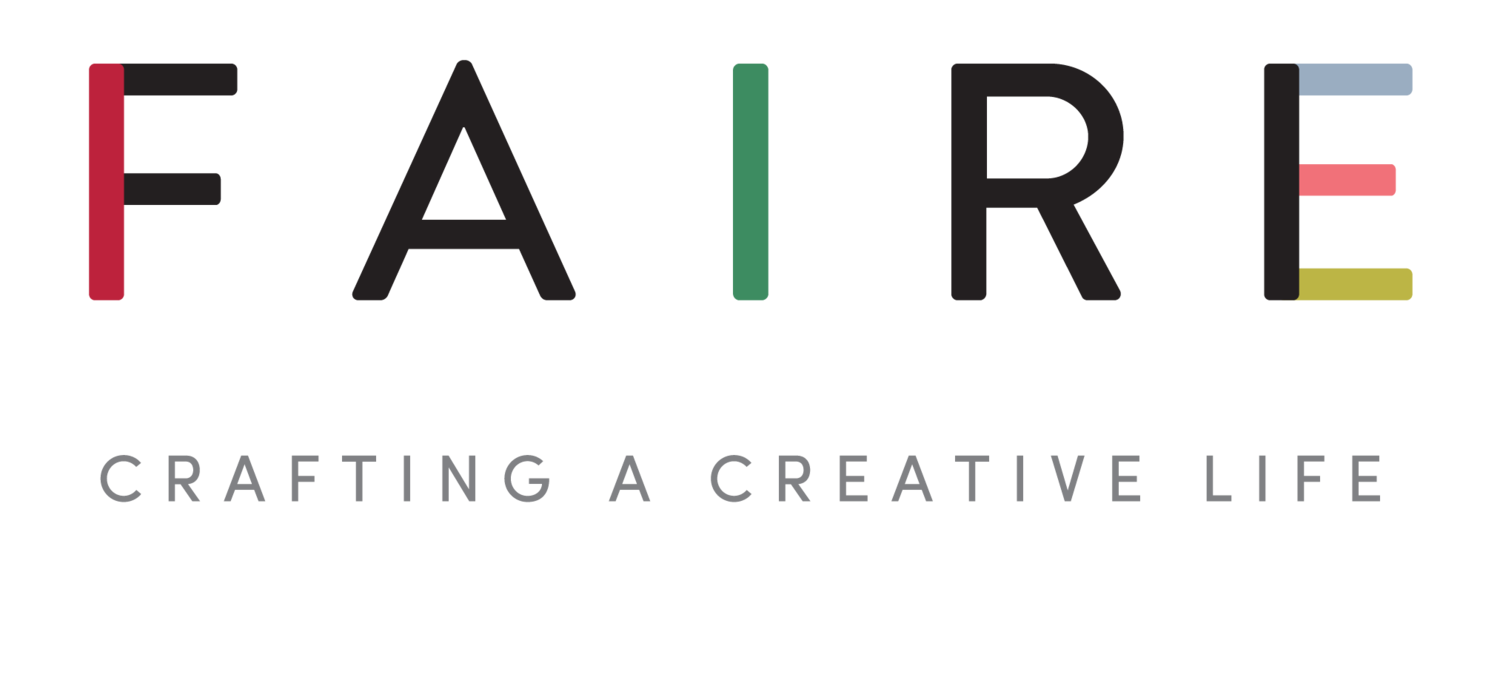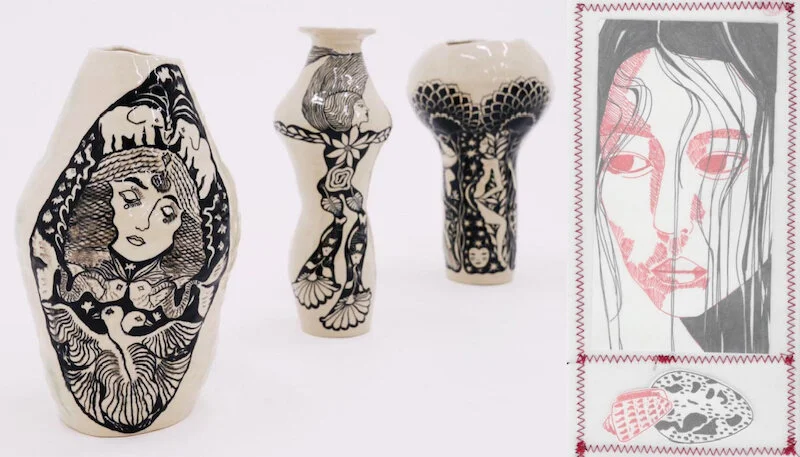The Journey of a Self-Taught Artist
In this feature, journalist Wesley Emmott spoke with self-taught artist Arizona Smith, whose art is intertwined with her relationship to tarot and spirituality, creating a dreamlike style. Arizona co-founded The Lurner Prize and The New Earth Art School with her partner Sam Mead.
Photo by Harriet Clare
Wesley: Do you lean towards a particular medium, between painting, fibre arts, and tarot cards?
Arizona: Painting is the key medium I work in but creativity for me is so unpredictable that I wouldn’t be surprised if in 5-years time I’m doing ceramics or something completely different. The thread that ties it all together is more about where it’s coming from—rather than the specific medium I use.
Currently, I am working on a few handmade rugs. I’m starting a series of cat rugs and a series of rug versions of my notebook pages.
The Purple Diamond Tarot Deck, photo on the left by Harriet Clare
W: How does spirituality as a whole impact your art?
A: [Art and spirituality] are totally connected, I see art as a reflection of the internal which nearly always has spiritual resonance. I love exploring and translating energetic landscapes into painted ones full of ‘everyday’ objects and I love expressing the animist qualities of objects in my work. I use my work as visual metaphors for feelings I can’t explain or images I see during dreams and meditations often, and then I find I am still unconsciously working with them for days, sometimes years. I’ve been working on some symbolic landscape paintings called snapshots of the psyche.
Dreaming, painting on A3 canvas board
I don’t really differentiate between spiritual and the rest of life, to me all of life is spiritual, but in terms of spiritual development I have a personal practice. I find that meditation, writing, making art, grounding, routine, and spending time with people who care about me is important for maintaining a good spiritual mind too.
W: Can you tell me a bit more about why tarot is important to you and how you got into it? Are you a tarot reader?
A: I have always had a spiritual relationship with animals and dreams and as a child, I often saw colours and shapes around people. I have had ‘power-dreams’ all my life and this has meant that I’ve always been open to ideas of energy, spirit guides, spirit animals, animism and that we are more than a physical body. Tarot became the perfect way for me to connect further as it is a visual medium of diving and communicating with your higher self and or guides. I am a tarot reader and I also offer illustrated readings in which I create an in-depth one card reading plus a unique talismanic image of the card specifically for the client. I’m very interested in using both the artistic and mystical skills together to help give people a clearer picture of what’s coming up.
Oye Drum, illustration
W: How do you sell your work? Do you have any galleries or pop-ups?
A: I sell the majority of my work through Instagram or word of mouth. For the tarot deck, I ran a successful Kickstarter. I currently have a couple of pieces in an exhibition at The Glades Shopping centre in Bromley as well as The Brockley Women’s Day Postcard Exhibition. But you can find most of my work on Instagram.
W: Is there a specific card you think best describes you?
A: I love working with the Empress card, and that’s one I’ve made as a rug as well. I like the Magician card as well, that’s probably my favourite tarot card.
The Purple Diamond Tarot Deck (left), The Empress, painting on wood (right)
W: How did you know you wanted to be an artist?
A: I think I was lucky to be brought up in a creative environment and this was stamped out a little bit when I went to school I think. Later when I was a teenager, 18 years old, I started messing around with paint again and it kind of blossomed from there. I had a few jobs where I was teaching art to children and it just grew and grew.
W: Can you talk about the uniqueness of The Lurner Prize, as a self-taught art prize, and your experience with starting it?
A: My partner, Sam Mead and I had recently become full-time artists and we just felt really grateful. For the first time in our lives, we had a tiny bit of money saved and we wanted to do something charitable with it. We were thinking about which charities to give it to and none of them captured the spirit of what we wanted to do. We felt that other prizes often have barriers or are too narrow in their criteria, we didn’t want to have a fee for entry, and we didn’t want to put any limits on who could enter other than being self-taught. So, we decided to make our own art competition and it was important to us that people got actual money so that they could do what they wanted with it.
The Empress rug (left), commissioned rug (right)
The Lurner Prize is a self-taught art prize open to anyone and everyone at every level of art. All entrants are exhibited. We also wanted a prize specifically for the self-taught artists because often they won’t have the artistic connections, they won’t have much knowledge of how to talk about their work in artistic terms, and they haven’t had tutelage or critiques to help them develop. This makes it hard to enter competitions that favour known artists or artists from known schools, but we are not anti-art schools.
Lastly, it was important to us to give a platform, and exhibit all of the artists who entered—it’s been really fun. It’s in its second year, and obviously, the pandemic has changed how things are done and we’re still looking for a place to do the final exhibition, but it’s amazing as we get to see everyone’s art. Some also write or send a video about their experience being a self-taught artist; some are practising artists selling work and others are non-practising artists, such as scientists. It’s such a varied group of people, it’s really nice to connect with that community, it’s quite emotional actually, reading about everyone’s experiences.
The Lurner Prize Participants, Silvie Cristofoli (left) first place, Storm Jackson-Payne (right) shortlisted
Within this group, we wanted to keep the experience level totally open. This is because we know that so many things just can’t be measured, some people have huge talent but have had to work so hard doing something to pay the bills that they haven’t been able to put the practice in. Some people have only just become confident enough to try, whilst others have diligently worked on their art day and night for years. We believe every artist should be celebrated and their work should be considered not just for skill but also for energy. This is because we believe it is the spirit of the artist that makes them great.
We have had a beautifully diverse mix of entrants, diverse in terms of age, race, bodily ability, experience in art and location. I think everyone’s creative and that you can do everything creatively. So, you don’t necessarily have to be a painter, but I think it really helps with your confidence and expression to be spending some time feeling creative and arty.
Sarasvati and the Swan, painting
Wesley Emmott is a passionate journalist and writer, working as a research assistant for author Charlie Hodges. He’s had work published in Esquire and the National Autistic Society’s magazine. Researching, writing, editing and sub-editing, all different steps in the process of writing articles that he works in. Currently, he writes for multiple magazines such as Sowing Seeds and FAIRE Journal, as well as a model for Zebedee.










